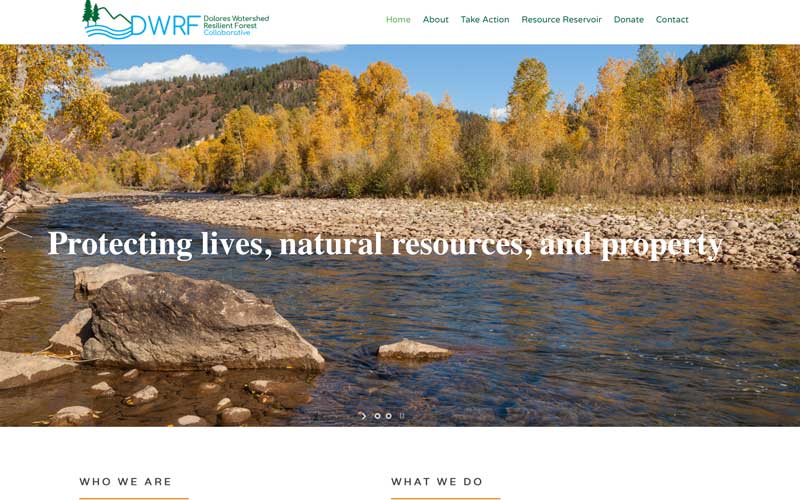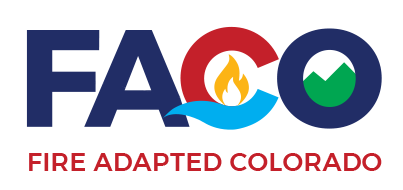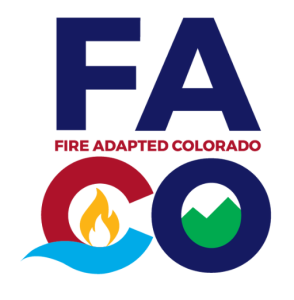Fire Adapted Colorado’s First Opportunity Fund Awards a Success
FACO’s Opportunity Fund supported six FACO member projects including three community events, one countywide planning project, branding materials for a collaborative effort, and a regional homeowner engagement project. We are so proud of our amazing partners and their work. It is amazing what a little bit of money and a lot of hard work can accomplish! We hope to continue this program ( and maybe even expand it) in the future – Let us know if you think this is an important program we should continue by contacting FACO.
Awarded Projects:
- Dolores Watershed Resilient Forest Collaborative (DWRF) – Developing outreach tools
- Eagle River Fire Protection District (ERFPD) – Red Cliff Mitigation Rendezvous
- Eagle County Wildfire Council (ECWC) – Pre-Incident Planning Project
- Grand County Wildfire Council (GCWC) – Grand County Community Chipping Days
- Middle Arkansas Wildfire Prevention Partnership (MAWPP) – Beulah Mitigation Training event
- West Region Wildfire Council (WRWC) – Engaging Homeowners in Risk Reduction Action
Accomplishments:
Dolores Watershed Resilient Forest Collaborative: Developed a brand for the watershed wildfire protection group including a logo and website as well as provided training for DWRF Collaborative staff to maintain website . The website will serve as a hub for information about watershed resilience in the community and will be promoted at several upcoming events.
Eagle River Fire Protection District: The department sponsored a collaborative community event to educate the Town of Red Cliff about their wildfire risk and the need to reduce fuels in critical areas. The event included disposing of slash created during the project. Slash disposal provided an incentive and brought awareness to home and business owners. Over four tons of slash was collected in the removal of ladder fuels and hazard trees from around homes, businesses, and the town. The group also removed slash from a historic cemetery and built camaraderie amongst the residents of Red Cliff and Eagle River Fire. ERFPD will continue to emphasize wildfire risk via the town newsletter each spring and maintain that awareness through wildfire season, encouraging homeowners to maintain defensible space. Check out the awesome Story Map they created below.

Eagle County Wildfire Council (ECWC: Funding kickstarted a wildfire pre-incident map product to build relationships as well as coordinate efforts and knowledge sharing between all fire agencies working in the county. The funding supported the initial staff time necessary to pull together the first working version of the map book of WUI areas and community critical information as well as a framework to continue to build this product into the future. The map book will be made available to all response agencies in paper form for the 2018 fire season. Next steps include creating a digital version of the maps that are easily shareable with other response agencies.
Grand County Wildfire Council (GCWC): Hosted two community chipping days in June providing free slash disposal to residents. These two events had over 70 landowners mitigate 131 acres after completing 310.5 hours of mitigation work on their properties for a total of 150 loads of slash chipped and removed. These events were supported by five volunteers working a total of 48 hours to complete the project. GCWC intends to host these community events again next year.
Middle Arkansas Wildfire Prevention Partners (MAWPP): The partnership used funds to publish homeowner training materials that were distributed during the Beulah Mitigation Training event combined with the Wildfire Community Preparedness Day. The event provided approximately 100 people with basic training on creating WUI defensible space, and was a good networking opportunity for private, local, state and federal agencies. In cooperation with Coalitions and Collaboratives, four homeowners within the WUI were awarded $1,000 sub grants for mitigation on their properties. This was a significant draw for people from the local area. MAWPP will continue to distribute these materials at training and events in their communities.
West Region Wildfire Council (WRWC): The Opportunity Fund award provided the last amount of required match needed to complete a Wildfire Risk Reduction grant for an unorganized rural WUI area with a very high wildfire risk. WRWC and partners completed a rapid wildfire risk assessment of every home in the identified area, which involved two counties (Montrose and Ouray). Residents participated in a Community Chipping Program coordinated by the WRWC to mitigate 4,725 cubic feet of hazardous material, and homeowners contributed 95 hours of in-kind time to mitigate fuels and build piles. Due to this engagement effort, thirteen homeowners requested site-visits and six homeowners in the project area are working through the Cost-Share Program to mitigate 25.55 acres of hazardous fuels on their properties. WRWC will continue outreach efforts through site visits and resident fire mitigation education.
Lessons the Awardees Learned and wanted to share:
DWRF: It takes more time than originally budgeted to work with consultants.
ERFPD: If possible it is better to expand the timeframe of a community project so homeowners and businesses can complete mitigation work at their own pace and work around personal commitments and work schedules in order to participate in the community event.
ECWC: It took time to gather all the required agreements to share data, utilize different mapping software and products, and develop consensus on project process. “This project helped to continue to build the working relationships of the fire organizations within Eagle County.”
GCWC: Discussed the possibility of reducing the length of chipping day so that the event would wrap up at 1 PM and allow enough time for the chipping contractor to complete chipping of stockpiled slash in one day.
MAWPP: One of the primary lessons learned from this event related to scheduling. The Beulah training occured on May 5 which placed it in direct competition for attendance with the Blossom Festival in Canon City, and the Cinco de Mayo events in Pueblo. Future similar events will need to be scheduled with these other public occasions in mind, or potentially, in concert with. Specifically, the Canon City Music and Blossom Festival venue would be a good opportunity to reach thousands of people during their weekend event.
WRWC: During this project the team lead was unable to complete a Community Assessment even though the project provided a free service due to a lack of enthusiasm from the community. “Even though a beneficial service can be offered at no cost, there must be support and desire to have this service completed. In hindsight, further communication and targeted outreach to garner enthusiasm for the project within the community was necessary to complete this assessment. In addition, community assessments in areas without any formalized structure (I.e. HOA or the like) are extremely hard to coordinate. Community Assessments are better suited for areas with pre-defined ‘community’ structure and coordination capabilities.”

